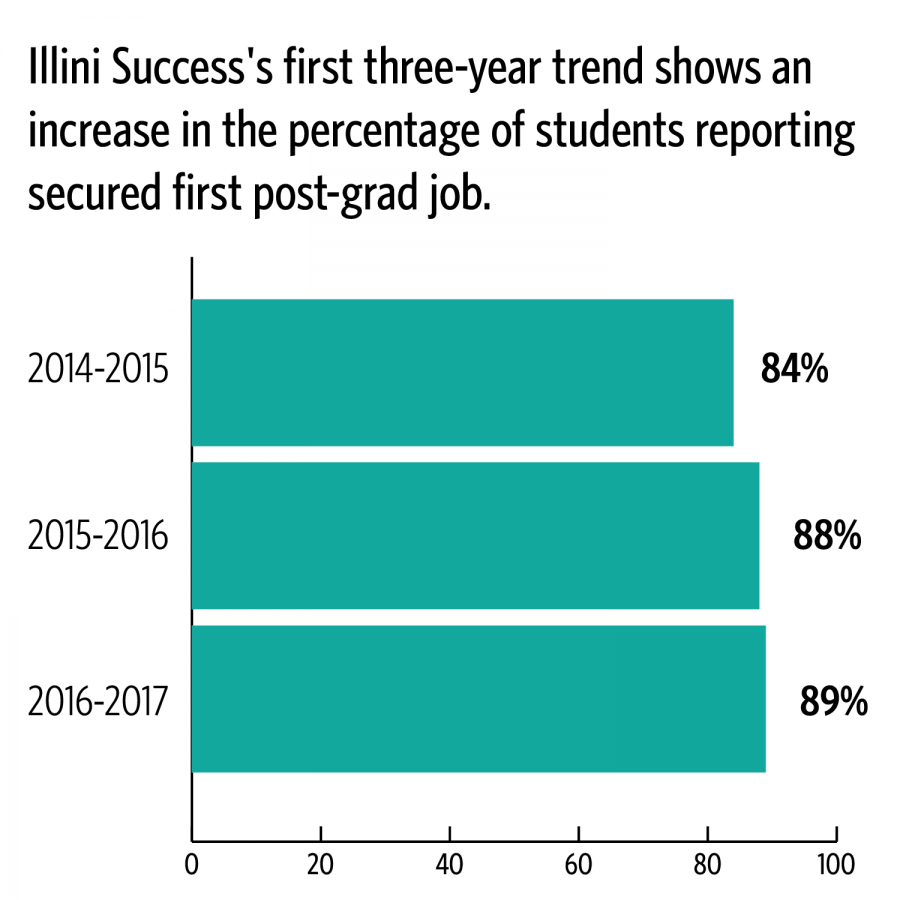Post-graduation employment rates expected to exceed national averages
March 15, 2018
Illini Success, an annual survey of University graduates, has released its first three-year trend data, which shows trends for employment, higher education and alternative paths for all undergraduate degrees.
The survey showed from 2014 to 2017, between 84 and 89 percent of graduates have secured a first destination. Approximately 73 percent of the students participated in the survey on average.
The campus-wide Illini Success initiative collects data by graduation year, which includes graduates from August, December and May.
Julia Panke Makela, associate director for assessment and research at the Career Center, said Illini Success was developed as a way to more thoroughly track what students were doing after graduation.
“We did not have a way to tell the story of what it meant to be a graduate from Illinois,” Makela said. “We find that this data is incredibly important for academic programming on campus, program review, and is also important for our campus as we talk about accreditation, government relations and how the University contributes to the state.”
Get The Daily Illini in your inbox!
Makela said she was surprised by how quickly the whole university got behind the effort.
“I thought it was going to take a long time but it felt like I was selling chocolate,” she said. “It takes a campus-wide initiative to pull off something this big.”
Illini Success has been working to compile a three-year trend to put the data in context. The trends show a strong and steady picture of graduate success. Although the National Association of Colleges and Employers has not yet released its data for the graduating class of 2016-2017, Makela expects the University to exceed the national level.
“When you put Illinois against national numbers coming out from NACE, in our first two years, we exceeded national averages in terms of percentages of students securing a first destination,” she said.
Makela hopes to turn the data into a career exploration tool, while continuing to ensure that it is private and confidential.
“Illini Success is fully Institutional Review Board approved,” she said. “We’re very concerned about data security and limits on who has access. What I want is for students to get meaning out of and to be able to use this data.”
Gail Rooney, director of career services and associate dean of leadership and career development, said the next step for Illini Success is the development of a student portal.
It is already possible for faculty and staff to utilize a portal to view data specific to their departments.
“A student portal will allow students to look at all of their different options,” Rooney said. “We want students to be able to go in and compare programs for decision-making.”
Rooney and Makela agree the reports break stereotypes about employment and salaries for majors in different colleges.
“The report might help students say, ‘Hey Mom and Dad, look, these people are getting jobs,’” Rooney said.
Rooney said she hopes to soon be able to compare the University’s data to those of comparable groups, like peer universities in the Big Ten.
“When we compare our individual data with the average of all of the national data, we are much better,” she said. “But that’s also because there are some small colleges and regional institutions in there, so we need a comparable group. Once we receive that NACE data, we will have another standard to which we can compare.”
Jessica Hogue, director of Media Career Services, said she hopes to improve the response rate of graduate students from the College of Media to improve the data’s reliability.
“We went from an 85 percent response rate last year to 87 percent this year, but my goal is to break that 90 percent response rate so we can see a full picture of what students are doing,” Hogue said.
The College of Media uses data from Illini Success in handouts for new students and enrolled students. The data is also discussed during presentations for the parents of incoming Media students, Hogue said.
“It’s great to educate students on what graduates are actually doing when they leave here versus what it seems like or what the rumor-mill has said,” she said. “It’s a great way to show students employers they may not have thought of. It helps us show that you can use media in every industry.”
The publication of Illini Success data has changed the conversations that Hogue has with students about future options.
“I can direct students to annual reports as a resource to help them think about employers,” she said. “It helps us better prepare students for what might be next for them after they leave here.”







